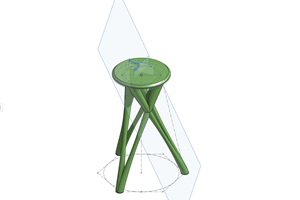Renishaw Tempus Technology Reduces Metal Additive Manufacturing Build Times
A new scanning algorithm for Renishaw’s RenAM 500 series of metal additive manufacturing systems enables the laser to fire while the recoater is moving, which over the build cycle can reduce total build time by up to 50% with no reduction in part quality.
The Tempus technology reduces the dwell time per layer, thereby shortening cycle times. Photo Credit: Renishaw
Renishaw’s Tempus technology enables users of its additive manufacturing (AM) systems to achieve significantly higher productivity, with no reduction in part quality. The company says the time and cost savings achieved through Tempus technology will further the use of AM as a volume production method and help drive wider adoption.
The Tempus technology incorporates a new scanning algorithm for Renishaw’s RenAM 500 series of metal AM systems, which enables the laser to fire while the recoater is moving, thereby saving up to nine seconds per build layer. Over the cycle time of the build, the time savings can cut the build time by up to 50%. Crucially, there is no reduction in part quality.
With Tempus technology, as the recoater spreads a layer of powder, the lasers “follow” the recoater, melting the powder being spread before the recoater completes its stroke. When the recoater goes back to the doser to collect more powder, the lasers “jump over” the recoater and continue melting the current layer, mitigating wiper time. As the recoater begins spreading the next layer of powder, the lasers finish the previous layer, and simultaneously start processing the new layer. Tempus technology reduces the dwell time per layer, thereby shortening cycle times.
The technology works using advanced scanning algorithms that sequence the layer data in a way that maximizes productivity while maintaining part quality. The optimization is well suited for some part geometries more than others, but all geometries can see some productivity benefits. Those parts with thin, vertical features, for example, are likely to experience higher productivity savings.
“Reducing cost per part is critical to the wider adoption of AM technology,” says Louise Callanan, director of Additive Manufacturing at Renishaw. “The dominant contributing factor to part cost for most components today is the time spent building the part on the machine itself. Reducing the amount of machine time per part, therefore results in more cost-effective production.”
The company says that is why Tempus technology is such a big leap forward. “Usually, the laser would turn off while the recoater is moving. Firing the laser while the recoater is moving minimizes the laser off-time per build,” Callanan says. “The time and cost saving Tempus brings will open AM up to mass production applications where the technology would previously have been unviable.”
Tempus technology is a standard fitment with new RenAM Ultra metal AM systems, which are available with quad- or single-laser configuration. Existing RenAM 500 series customers can access Tempus as a paid-for upgrade. Renishaw data shows that retrofitting Tempus technology to an existing system is the equivalent of adding an extra laser, and enables existing customers to make the most of their machine investment.
For uses in consumer electronics and computing, Renishaw has entered into an exclusive partnership agreement with metal component expert Alloyed, which has been using Tempus technology since 2021.
Renishaw offers a suite of additive manufacturing technologies to help customers develop a high quality, productive end-to-end solution, and has launched software, hardware and processes that enhance the additive manufacturing process chain. Recent launches include Optical System Verification (OSV), a three-stage in-house laser testing and calibration process that enables users to quickly confirm machine performance.
- Read about the Renishaw partnership with CCAT to accelerate technology adoption. Renishaw provided industrial metrology and additive manufacturing equipment to the Connecticut Center for Advanced Technology Inc. (CCAT), as well as sales and applications liaisons for product demonstrations, webinars, training and support.
- Learn how Renishaw metal additive manufacturing enables Domin to create CO2-reducing valve. By using Renishaw’s RenAM 500Q AM system, Domin has created a servo valve that saves one ton of CO2 per year compared to competing products.
Related Content
Implicit Modeling for Additive Manufacturing
Some software tools now use this modeling strategy as opposed to explicit methods of representing geometry. Here’s how it works, and why it matters for additive manufacturing.
Read MoreTo Scale Additive Manufacturing, Separate Design and Production
Spokbee’s online marketplace is designed to ease the launch and sale of customizable, 3D printed products. Its flexibility comes from cloud-based CAD and a distributed network of service bureaus for production.
Read More3D Printed Cutting Tool for Large Transmission Part: The Cool Parts Show Bonus
A boring tool that was once 30 kg challenged the performance of the machining center using it. The replacement tool is 11.5 kg, and more efficient as well, thanks to generative design.
Read MoreCopper, New Metal Printing Processes, Upgrades Based on Software and More from Formnext 2023: AM Radio #46
Formnext 2023 showed that additive manufacturing may be maturing, but it is certainly not stagnant. In this episode, we dive into observations around technology enhancements, new processes and materials, robots, sustainability and more trends from the show.
Read MoreRead Next
Video: Intelligent Layering Metal 3D Printing at 3DEO
Contract manufacturer 3DEO delivers metal parts using Intelligent Layering, a binder jetting-like 3D printing process the company developed and operates internally. Here’s how it works.
Read MoreGE Additive Rebrands as Colibrium Additive
As part of the brand name transition, both the Concept Laser and Arcam EBM legacy brands will be retired.
Read More3D Printing Brings Sustainability, Accessibility to Glass Manufacturing
Australian startup Maple Glass Printing has developed a process for extruding glass into artwork, lab implements and architectural elements. Along the way, the company has also found more efficient ways of recycling this material.
Read More










.png;maxWidth=300;quality=90)













